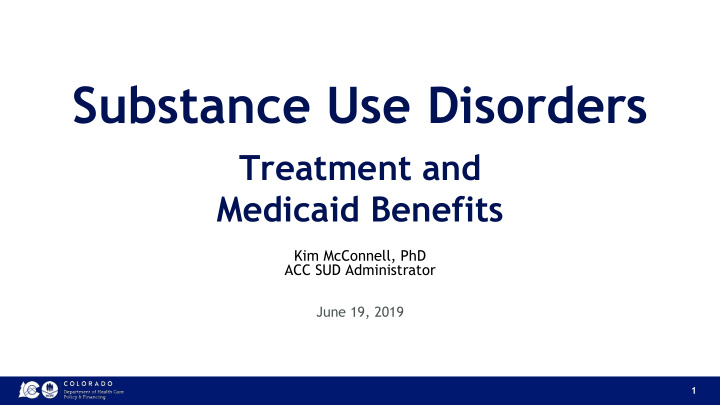



Substance Use Disorders Treatment and Medicaid Benefits Kim McConnell, PhD ACC SUD Administrator June 19, 2019 1
Our Mission Improving health care access and outcomes for the people we serve while demonstrating sound stewardship of financial resources 2
What is the SUD problem in Colorado? SOURCE: “Colorado Drug Trends,” S. Russell. Drug/Alcohol Coordinated Data System (DACODS), Office of Behavioral Health (OBH), Colorado Department of Human Services (CDHS) (2018). 3
CO overdose rates over time 4
Opioid Overdose Deaths in Colorado In Colorado, there were 1,012 drug overdose deaths in 2016 • Which drugs were responsible here? Drug Number of deaths in CO in 2017 Prescription Opioids 373 (rising) Heroin 224 Fentanyl 81 (more than doubled since 2016) Methadone 58 Source: Colorado Rx Abuse Task Force data 5
Opioid Misuse in Colorado 25% of Coloradoans acknowledge using pain relief medications in a way not prescribed by their physician. 29% report using pain medications prescribed for someone else. 1 in 7 HIGH SCHOOL STUDENTS reported taking prescription medications without a doctor’s prescription (2004 to 2013). Unintentional drug poisoning deaths jumped almost 82% from 2004 to 2013. Sources: Colorado Dept of Ed. Healthy Kids CO Survey (2013), Colorado Consortium for Prescription Drug Overdose Deaths, 2014 Statewide survey by National Research Center. 6
Opioid addiction process • Changes in downregulation of receptors in the brain begin at the first dose of opioids • Withdrawal symptoms are present at discontinuation within 3 weeks of use • 20% of people prescribed a 15-day course of opiates following surgery report using them one year later. (38% for those prescribed a 30 day course) 7
What is addiction? Biological genetic, psychological, social and spiritual factors contribute to the development of the disease. 8
What is Medication Assisted Treatment (MAT)? Naloxone – standing orders at CO pharmacies, co-prescribing, colocation • with AEDs is a goal Buprenorphine, Suboxone, Subutex, Sublocade … • Lucemyra (2018 FDA approval) • Methadone • Naltrexone (Vivitrol) • Acamprosate • Antabuse • 9
Substance Abuse Treatment Services Level 0.5 Early intervention Level 1 Outpatient Services Level 2 Intensive Outpatient Services (IOP) or partial hospitalization Level 3 Residential or Inpatient Services Level 4 Medically Managed Intensive Inpatient Services 10
Services Currently Covered for Health First Colorado Members ✓ Screening and Brief Intervention ✓ Outpatient Services ✓ IOP (covered under the state plan as outpatient services) ✓ Medically Managed Intensive Inpatient Services (in acute care hospital settings) ✓ Special Connections Residential and Inpatient services are not currently covered. All levels of care are available for children under the age of 21 through EPSDT. 11
What is the 1115 SUD Waiver? • Restriction on IMDs • HB18-1136 requires HCPF to seek federal authority to add inpatient and residential treatment to the SUD benefit • Benefit is projected to begin July 2020 12
Waiver Requirements Access to critical levels of care ❑ Evidence-based, SUD-specific patient placement criteria ❑ Use of nationally recognized standards to set provider qualifications ❑ Sufficient provider capacity , including medication assisted treatment ❑ Treatment and prevention strategies to address opioid abuse ❑ Improved care coordination and transitions ❑ 13
Waiver Timeline 14
Upcoming stakeholder meetings • Wednesday, June 19 from 3:30 -5:30 pm in Colorado Springs • Thursday, June 20 from 8:00 – 10:00 am in Greeley • Thursday, June 20 from 3:30 -5:30 pm via Zoom. Two hearings to take place in August during the public notice period. Dates and locations TBD. 15
Stakeholder Updates Please visit our stakeholder webpage for updates and news on the SUD inpatient and residential benefit: https://www.colorado.gov/pacific/hcpf/ensuring-full- continuum-sud-benefits 16
17
Kim McConnell ACC SUD Administrator Kim.mcconnell@state.co.us Shingo Ishida ACC SUD Benefits Specialist Shingo.ishida@state.co.us 18
Thank You! 19
Recommend
More recommend